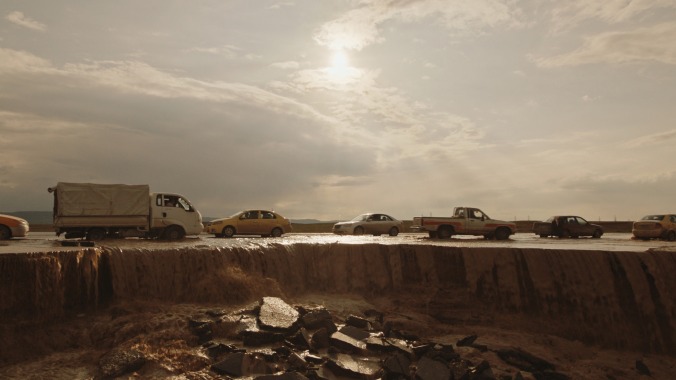Notturno offers a striking look at the scars, but not the horrors, of life in a war zone
Film Reviews Francesco Rosi
How does one sleep near a war zone? The question, though never directly posed, is given multiple answers in Gianfranco Rosi’s documentary Notturno: on bedrolls, on couch cushions, in a hospital. Rosi, who shot the film “over the past three years along the borders of Iraq, Kurdistan, Syria, and Lebanon” (the only context given for what we’re seeing), takes his camera to classrooms, military bases, ruins, therapy. Somewhere along the way, he appears to have spent an extended period of time with the Kurdish Peshmerga. In one sequence, a group of female soldiers rests under blankets with AKs by their sides; in another, a male machine gunner complains about his comrade’s bumpy driving while lying down after a long patrol.
Sleep and its attendant dreams are hardly the only nocturnal activities being disturbed here. A couple goes through the small talk of a date while the telltale rattle of full-auto gunfire echoes somewhere in the distance. Later, in a remarkable scene, the camera follows a night fisher as he paddles his little boat through reeds; huge fires blaze somewhere on the horizon, eventually mixing with the orange of the early morning. Rosi’s compositions, static and mostly wide angle, are ennobling, albeit ambiguously. Life is going on, but not as usual.
While the lack of narration or background information necessitates a certain amount of guesswork, there is never any doubt about the subject: The threat and trauma of the Islamic State group looms over the disconnected vignettes and vast, empty landscapes. To say that Rosi has made a choice to keep it unseen implies that something might be gained through its documentation; in fact, it is hard to think of another group that so enjoys having its horrors witnessed. This is the moral bind of its depiction, the nihilistic masterstroke of its mid-2010s viral propaganda: There is nothing to be shown that the world’s premier snuff film studio doesn’t want to be seen.
Rosi, who previously tackled the European migrant crisis in the Oscar-nominated Fire At Sea, instead attempts to evoke the psychic scars. In Notturno’s longest and most gut-wrenching sequence, filmed in a clean, nondescript classroom, a counselor gently tries to get Yazidi refugee children to talk about the gruesome violence depicted in their drawings: figures in black and orange, decapitations, big-headed adults spurting blood. Later, we hear a devastating series of voicemails left by a woman who was kidnapped by the Islamic State for ransom. We don’t find out what happened to her, though perhaps we already know.
Despite the opaque, gallery-art approach, Rosi’s aim is basically journalistic. It is meant to expose us to someone else’s everyday reality, which Notturno appears to place in a larger history of ethnic cleansing with an early scene that visits an abandoned prison. There are some bold visual metaphors; the most memorable is the sight of a flooded road, on which cars and trucks steer around a large crater (caused by erosion, according to the press notes). But there are also longueurs. Rosi shares with the global art film tradition a taste for filler scenery and a seemingly limitless fascination with rehearsal, devoting multiple lengthy scenes to a didactic play put on by a group of psychiatric patients; the resulting distancing effects and zone-outs are probably the opposite of what was intended. But what is a filmmaker supposed to do, make it exciting?
2 Comments
another interesting movie that I’ll be sure to watch AFTER we survive the pandemic and the last 18 hours of this fucking monstrosity of a presidency. Right now my mind can only handle Archer and Tosh.0 marathons.
If you want ‘exciting’, there’s plenty of Marvel spectacle for you. I, for one, was never bored during this elegiac and haunting film, and none of the luminous and painterly images presented therein felt remotely like ‘filler’ to me.